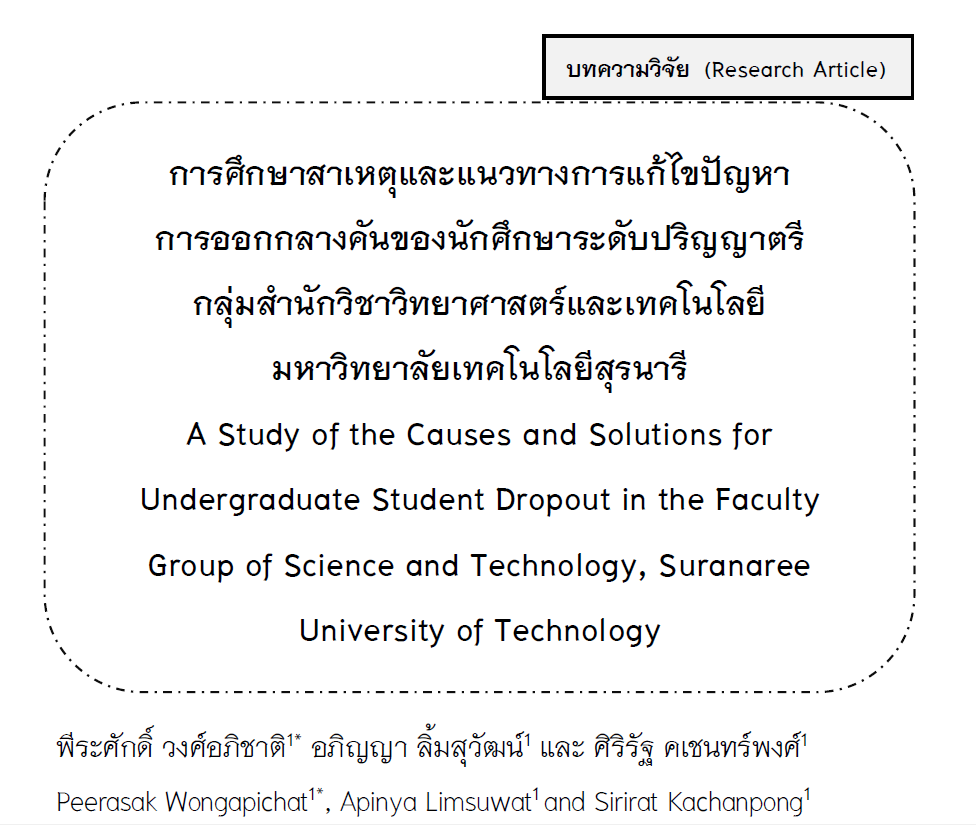A Study of the Causes and Solutions for Undergraduate Student Dropout in the Faculty Group of Science and Technology, Suranaree University of Technology
Keywords:
Drop out, Solution, CauseAbstract
This research aims to investigate the factors contributing to the dropout rate among undergraduate students in the Faculty Group of Science and Technology at Suranaree University of Technology and to explore potential solutions. The study population includes 14 students on academic probation (GPA below 1.80), 42 regular students (GPA 1.80 and above), and 24 faculty members. In-depth interviews were conducted to collect data, which was then categorized and analyzed using content analysis. The findings revealed that the primary reasons for student dropout were student-related factors such as lack of motivation and personal issues. Secondary factors included family-related problems, such as insufficient financial support and parental pressure to study in an undesired field. Additionally, instructional factors, such as uninteresting course content or ineffective teaching methods, contributed to the dropout rate. Furthermore, interviews with regular students indicated that students at risk of dropping out faced similar challenges related to personal factors, family issues, and teaching methods. Faculty members, on the other hand, attributed the problem primarily to student and family factors, as well as systemic issues within the university, including the three-semester system and inadequate student support services. To address these issues, the following recommendations were proposed: developing a student monitoring system, providing targeted support for at-risk students, reducing class sizes, fostering stronger student-teacher relationships, improving teaching methods, and enhancing the student recruitment process to attract more qualified applicants.
References
ดุษฎี โยเหลา. (2556). การสุ่มตัวอย่างหรือการเลือกตัวอย่าง (SAMPLING). จาก http//www.phd.ru.ac.th/newszian/files/20130919_135906การเลือกกลุ่มตัวอย่าง.pdf.
มหาวิทยาลัยเทคโนโลยีสุรนารี. (2560). ข้อบังคับมหาวิทยาลัยเทคโนโลยีสุรนารี ว่าด้วยการศึกษาขั้นปริญญาตรี พ.ศ. 2561. นครราชสีมา: มหาวิทยาลัยเทคโนโลยีสุรนารี.
มหาวิทยาลัยเทคโนโลยีสุรนารี. (2561). รายงานประจำปี 2561 มหาวิทยาลัยเทคโนโลยีสุรนารี. นครราชสีมา: มหาวิทยาลัยเทคโนโลยีสุรนารี.
ยุพิน พิพิธกุล. (2527). การเปรียบเทียบผลสัมฤทธิ์ทางการเรียนของนิสิตที่ใช้ และไม่ใช้ชุดการสอน สำหรับวิชาพฤติกรรมการสอนคณิตศาสตร์ (รายงานการวิจัย). กรุงเทพฯ: จุฬาลงกรณ์มหาวิทยาลัย.
Adelman, C. (2006). The toolbox revisited Paths to degree completion from high school through college. U.S.: Department of Education.
Astin, A. W. (1984). Student involvement A developmental theory for higher education. Journal of College Student Personnel, 25(4), 297-308.
Bean, J. P., & Metzner, B. S. (1985). A conceptual model of nontraditional undergraduate student attrition. Review of Educational Research, 55(4), 485-540.
Bloom, B.S. (1976). Human Characteristic and School Learning. New York: McGraw–Hill.
Cabrera, A. F., Nora, A., & Castaneda, M. B. (1992). The role of finances in the persistence process A structural model. Research in Higher Education, 33(5), 571-593.
Cabrera, N. L., Miner, D. D., & Milem, J. F. (2013). Can a summer bridge program impact first-year persistence and performance? A case study of the New Start Summer Program. Research in Higher Education, 54(5), 481-498.
Carroll, J.B. (1989). The Carroll Model A 25-year Retrospective and Prospective View. Educational Researcher, 18(1), 26–31.
Carter V. Good, (1959). Attitude. Retrived Oterber 25, 2009, from http//www.novabizz.Ace/Attitude.html.
Carter V. Good. (1973). Dictionary of Education. New York: McGraw-Hill Book.
Crisp, G., & Cruz, I. (2009). Mentoring college students A critical review of the literature between 1990 and 2007. Research in Higher Education, 50(6), 525-545.
Cruze, Wendel W. (1974). Education Psychology. New York: Ronal Press.
Delen, D. (2010). A comparative analysis of machine learning techniques for student retention management. Decision Support Systems, 49(4), 498-506.
Goldrick-Rab, S. (2018). Paying the price College costs, financial aid, and the betrayal of the American dream. The Review of Higher Education, 42(1), E-7-E-10. DOI https://doi.org/10.1353/rhe.2018.0041.
Johnson, L.J., & LaMontagne, M.J. (1993). Research methods using content analysis to examine the verbal or written communication of stakeholders within early intervention, Journal of Early Intervention, 17(1) 73-79.
Kuh, G. D., Cruce, T. M., Shoup, R., Kinzie, J., & Gonyea, R. M. (2008). Unmasking the effects of student engagement on first-year college grades and persistence. The Journal of Higher Education, 79(5), 540-563.
Kuh, G. D., Kinzie, J., Schuh, J. H., & Whitt, E. J. (2011). Student success in college: Creating conditions that matter. San Francisco, CA: Jossey-Bass.
Linderman, R.H., Merenda, P.F., & Gold, R.Z. (1978). Introduction to Bivariate and Multivariate Analysis. London Scott, Foresman.
Museus, S. D. (2014). The culturally engaging campus environments (CECE) model A new theory of success among racially diverse college student populations. Springer Nature: In Higher education Handbook of theory and research, 189-227.
Pascarella, T. and Terenzin, P. (2005). How college affects students A third decade of research (2nd ed.) San Francisco: Jossey-Bass.
Porter, S. R., and Umbach, P. D. (2006). College major choice an analysis of person–environment fit. Research in Higher Education, 47(4), 429-449.
Reason, R. D. (2009). An examination of persistence research through the lens of a comprehensive conceptual framework. Journal of College Student Development, 50(6), 659-682.
Robbins, S. B., Lauver, K., Le, H., Davis, D., Langley, R., & Carlstrom, A. (2004). Do psychosocial and study skill factors predict college outcomes? A meta-analysis. Psychological Bulletin, 130(2), 261-288.
Rokeach, M. (1970). Belief, Attitude and Value A Theory of Organization and Change. San Francisco: Josey-Ban.
Strange, C. C., and Banning, J. H. (2015). Designing for learning: Creating campus environments for student success. Jossey-Bass a Wiley Brand.
Tinto, V. (1975). Dropout from higher education A theoretical synthesis of recent research. Review of Educational Research, 45(1), 89-125.
Tinto, V. (1993). Leaving college: Rethinking the causes and cures of student attrition (2nd ed.). Chicago, IL: University of Chicago Press.
Tinto, V. (2012). Completing college Rethinking institutional action. Chicago: University of Chicago Press.

Downloads
Published
How to Cite
Issue
Section
License
Copyright (c) 2024 Phayao University

This work is licensed under a Creative Commons Attribution-NonCommercial-NoDerivatives 4.0 International License.
ผู้นิพนธ์ต้องรับผิดชอบข้อความในบทนิพนธ์ของตน มหาวิทยาลัยพะเยาไม่จำเป็นต้องเห็นด้วยกับบทความที่ตีพิมพ์เสมอไป ผู้สนใจสามารถคัดลอก และนำไปใช้ได้ แต่จะต้องขออนุมัติเจ้าของ และได้รับการอนุมัติเป็นลายลักษณ์อักษรก่อน พร้อมกับมีการอ้างอิงและกล่าวคำขอบคุณให้ถูกต้องด้วย
The authors are themselves responsible for their contents. Signed articles may not always reflect the opinion of University of Phayao. The articles can be reproduced and reprinted, provided that permission is given by the authors and acknowledgement must be given.







